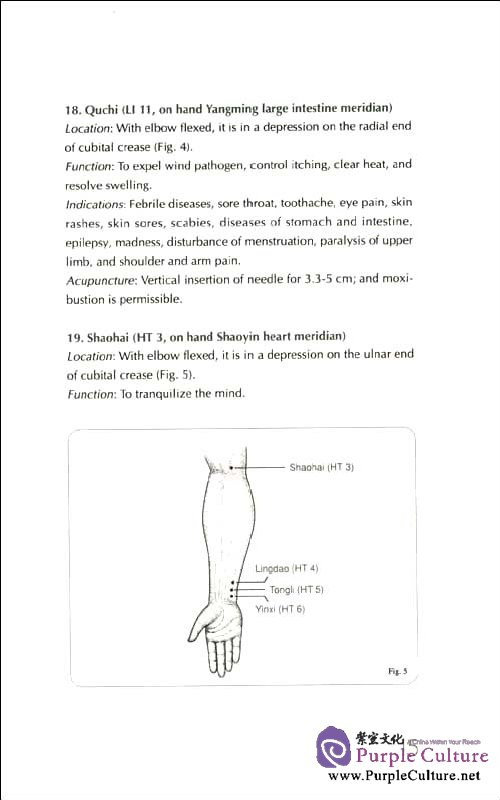Sample Pages Preview

15. Xialian (LI8, on hand Yangming large intestine meridian)
Location: On the connecting line between Yangxi (LI 5) and Quchi(LI 11) acupoints and 1.3 cm from Quchi (Fig. 4).
Function: To adjust qi and promote transportation in organs.
Indications: Headache, dizziness, abdominal pain, acute mastitis, and pain in elbow and arm.
Acupuncture: Vertical insertion of needle for 1.6 cm; and moxibustion is permissible.
16. Shanglian (EI 9, on hand Yangming large intestine meridian)Locationi On the connecting line between Yangxi (LI 5) and Quchi(LI 11) acupoints and 10 cm from Quchi (Fig. 4).
Function: To adjust qi and promote transportation in organs.
Indications: Headache, pain in shoulder and arm, abdominal pain, diarrhea, and hemip Jegia.
Acupuncture: Vertical insertion of needle for 1.6-3.3 cm; and moxibustion is permissible.
17. Shousanli (EI 10, on hand Yangming large intestine meridian)
Location: On the connecting line between Yangxi (LI 5) and Quchi(LI 11) acupoints and 6.7 cm from Quchi (Fig. 4).Function: To clear heat, improve vision, adjust qi, and promote transportation in organs.
Indications: Abdominal distension, diarrhea, eye diseases, toothache, hemiplegia, and hand, arm, and elbow pain.
Acupuncture: Vertical insertion of needle for 1.6-3.3 cm; and moxibustion is permissible.
Preface
As an important component of traditional Chinese medicine, the therapies applied to the hand-hand therapy-are a group of unique therapeutic methods developed by medical specialists and common people in China through their medical practice, productive activity, and daily lives for hundreds of years.
According to the meridian theory of traditional Chinese medicine, the hand is closely connected through meridians with the skin, blood vessels, muscles, ligaments, bones, and internal organs of the body. Pathological disease in patients is reflected on their hands; and the stimulating and therapeutic effects of massage, acupuncture, herbal bath, and qigong can be transmitted through meridians to adjust and stimulate potential energy, immunity, resistance to disease, and physical well-being to maintain health and prolong life.
Hand therapy can be easily practiced and widely applied to treat many diseases, often with good therapeutic results, and without toxic side effects. These therapies have found favor among vast numbers of patients over the years. To help foreign readers understand, learn, and practice this unique hand therapy, the compilers reviewed a large amount of ancient and modern medical literature in China, and have collected the useful experience of specialists in this field to systematically present the sum of this beneficial knowledge.
